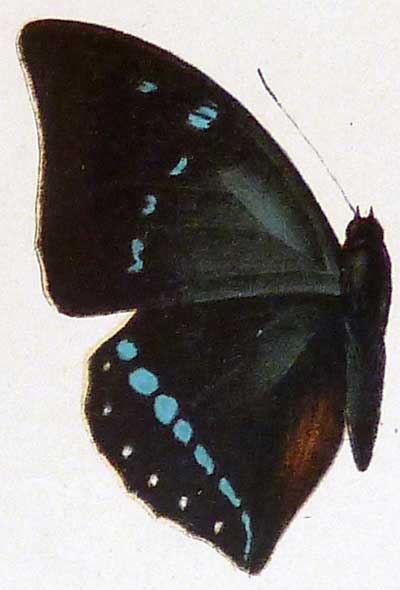
Superregnum: Eukaryota
Cladus: Unikonta
Cladus: Opisthokonta
Cladus: Holozoa
Regnum: Animalia
Subregnum: Eumetazoa
Cladus: Bilateria
Cladus: Nephrozoa
Cladus: Protostomia
Cladus: Ecdysozoa
Cladus: Panarthropoda
Phylum: Arthropoda
Subphylum: Hexapoda
Classis: Insecta
Cladus: Dicondylia
Subclassis: Pterygota
Cladus: Metapterygota
Infraclassis: Neoptera
Cladus: Eumetabola
Cladus: Endopterygota
Superordo: Panorpida
Cladus: Amphiesmenoptera
Ordo: Lepidoptera
Subordo: Glossata
Cladus: Coelolepida
Cladus: Myoglossata
Cladus: Neolepidoptera
Infraordo: Heteroneura
Cladus: Eulepidoptera
Cladus: Ditrysia
Cladus: Apoditrysia
Cladus: Obtectomera
Superfamilia: Papilionoidea
Familia: Nymphalidae
Subfamilia: Charaxinae
Tribus: Charaxini
Genus: Charaxes
Species: Charaxes zelica
Charaxes zelica, the zelica untailed charaxes, is a butterfly in the family Nymphalidae. It is found in Guinea, Ivory Coast, Ghana, Nigeria, Cameroon, Gabon, the Republic of the Congo, the Central African Republic, the Democratic Republic of the Congo, Angola, Sudan, Uganda, Kenya, Tanzania and possibly Sierra Leone.[3] The habitat consists of forests with altitudes of 800–1,000 metres (2,600–3,300 ft).
Adult males feed on otter and bird droppings and both sexes are attracted to fermented fruit.
The larvae feed on Pterocarpus santalinoides, Paullinia pinnata, Albizia zygia, Lonchocarpus cyanescens, Dalbergia, Millettia, Dichapetalum and Trachyphrynium species.
Description
For a key to the terms used, see Glossary of entomology terms.
Original description:
Male Wings above blue-black with the fringe orange, the basal area shot with dark blue-green. Front-wings traversed beyond the middle by a series of six small spots the third to fifth lunular, the others sub-ovate; a sub-costal of the same colour between them and the apex. Hind-wings with an oblique discal series of seven blue spots occurring from the apex to the anal angle; eight sub-marginal white spots delicately encircled by blue scales and seven linear marginal spots. Abdominal margin and body brown, coarsely clothed with hair.
Wings below silky olivaceous, the apical area inclining to ochraceous a sharply defined by a curved line running from the anal angle of hind to the apex of the front-wings; the basal area crossed by two angular silvery bands, terminating in the front-wings in two ochraceous spots; the interior band limited outwardly, and the exterior one inwardly, a black and white line.missing text Front-wings with a pale undulated line upon apical area, two black ocellate spots with white irides near the base, and a black stria at the missing text of the cell. Hind-wings with a large sub-anal silver patch and eight white sub-marginal spots, the three nearest the anal angle pupillated with black; muddy brown, the centre of the thorax, palpi, tibie, and tarsi ochraceous.
Expanse of wings 3 and 1/4 inches. Inhabits West Africa (Ashanti ?).
This beautiful species, which I hope shortly to be able to figure, is allied to Tiridates and Mycerina, the colouration of the upper surface being somewhat similar to the former, the shape of the wings and underside colouring more nearly approaching the latter species.
British Museum 5 May 1869.
Descriptions are also provided van Someren.[4]
Differs from the related Charaxes lycurgus in the straighter hindwing distal border [5]
Subspecies
C. z. zelica (Guinea, Sierra Leone, Ivory Coast, Ghana, western Nigeria)
C. z. depuncta Joicey & Talbot, 1921 [6](southern Sudan, Uganda, western Kenya)
C. z. rougeoti Plantrou, 1978 [7](eastern Nigeria, Cameroon, Gabon, Congo, Central African Republic, Democratic Republic of the Congo, northern Angola)
C. z. toyoshimai Carcasson, 1964[8] (north-western Tanzania)
Taxonomy
Charaxes zelica is a member of the species group Charaxes lycurgus. The supposed clade members are:
Clade 1
Charaxes lycurgus - nominate
Charaxes porthos
Charaxes zelica
Clade 2
Charaxes mycerina
Charaxes doubledayi
References
Butler, A.G. 1869 Description of a fine new Charaxes from Africa. Entomologist’s Monthly Magazine 6: 28-29.
"Charaxes Ochsenheimer, 1816" at Markku Savela's Lepidoptera and Some Other Life Forms
Afrotropical Butterflies: File H - Charaxinae - Tribe Charaxini
Victor Gurney Logan Van Someren 1974 Revisional notes on African Charaxes (Lepidoptera: Nymphalidae). Part IX. Bulletin of the British Museum of Natural History (Entomology) 29 (8):415-487. [1]
Kielland, J. 1990 Butterflies of Tanzania. Hill House, Melbourne and London: 1-363.
Joicey, J.J., & Talbot, G. 1921. New Lepidoptera collected by Mr. T.A. Barns in east central Africa. Bulletin of the Hill Museum, Witley 1: 40-166.
Plantrou, J. 1978 Note sur les Charaxes du groupe ‘porthos-zelica’ et nouvelle revision de la taxonomie du groupe (Lepidoptera Nymphalidae). Annales de la Societe Entomologique de France (N.S.) 14 (3): 515-533.
Carcasson, R.H. 1964. New butterflies from the Kigoma area of western Tanganyika.Journal of the East Africa Natural History Society & Coryndon Museum 24 (4): 62-67.
Victor Gurney Logan Van Someren, 1974 Revisional notes on African Charaxes (Lepidoptera: Nymphalidae). Part IX. Bulletin of the British Museum of Natural History (Entomology) 29 (8):415-487. [2]
Seitz, A. Die Gross-Schmetterlinge der Erde 13: Die Afrikanischen Tagfalter. Plate XIII 32
Retrieved from "http://en.wikipedia.org/"
All text is available under the terms of the GNU Free Documentation License

